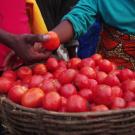This fact sheet describes and depicts the six stages of maturity for tomatoes, as well as information on quality and common defects. This document was created as part of the Horticulture Innovation Lab project focused on reducing postharvest loss in Rwanda.
Maturity indices
Tomatoes progress from completely green in the first stage of maturity to more than 90% of the tomato surface being red in the sixth and final stage of maturity. Tomato harvest begins in the second stage when there is a break of color from green to tannish-yellow covering less than 10% of the tomato surface. Tomatoes for drying should be harvested in the sixth and final stage when over 90% of the surface is red. The weight, size, and Brix increase throughout the ripening process, while the firmness decreases.
Quality
High quality tomatoes are undamaged. Damaged tomatoes should be rejected, as damaged parts may harbor microorganisms. Tomatoes that are fully red are suitable for direct sale. Tomatoes that are still partially green are suitable for storing for 3-4 days until they ripen before selling.
Common quality defects include decay, insect damage, cracks, and sunburn. Decay is caused by microorganisms. Insect damage may lead to the introduction of microorganisms. Cracks are a sign of insufficient mineral nutrients in the peel. Sunburn is a loss of pigmentation on the sun exposed side of the fruit.
Tomato harvesting
Tomatoes can be harvested manually by using a cutting tool like scissors. Small stems should be left on the fruit to limit the deterioration.

